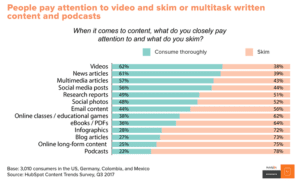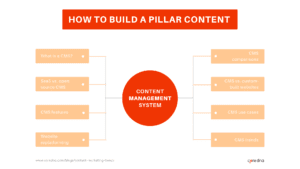
- Content Marketing, Marketing Trends in 2020, Video Content
Recent articles
our mailing list
Top 5 Content Marketing Trends for 2020

Since 2020 is just around the corner, it is worth having a look on what trends will dominate content marketing next year.
First of all we can be certain, that content marketing will more relevant than ever.
However, content creation and delivery will experience a major change in 2020.
For a brief overview, check out the following list of Top 5 content marketing trends for 2020:
- 1. Video is the key to success
- 2. Purposeful content wins
- 3. Own a topic and become an authority
- 4. Customer-first with ultra-targeting
- 5. Align content with user and search intents to be top of the game
If you think you need more insights on how to get started to succeed in content marketing, please feel free to reach out to us.
In case, you are a pro already and want to stay at the top in 2020, feel free take the following insights to win.
1. Video is the key to success
So far, blog posts have been the most trusted type of content for creators.
But do customers really read pages of blog posts? No.
People love video

How to win the game:
- Invite your audience to join the fun and feature their UGC
- Build your own short clips for behind-the-scenes content
- Do webinars, Q&A sessions (live), Expert interviews
- Platforms to post: YouTube, Instagram, Facebook, TikTok, LinkedIn, Your own website
2. Purposeful content wins
Continuing from 2019 trends, the need for stellar, purposeful content isn’t stopping as we head into 2020.
More and more creators and marketers understand the need for content of the highest quality.
90% of the most successful content marketers put their audience’s information needs first
over their promotional message, according to Content Marketing Institute’s B2B report.
The content marketing area where spending increased the most from 2018-2019 was content creation.

How to win the game:
- Understand better of what your target audience needs from search results for a given keyword
- Improve writing with consistency for the brand’s tone and style
- Do a better research and use stats and data from reputable sources
- Apply more depth and a deeper exploration of your topics
- Create high quality visuals, such as branded imagery, infographics and custom blog images
3. Own a topic and become an authority
Google’s algorithms have evolved. Not only do they look on the quality of a single page when ranking said page.
Also, Google evaluates the context of a given page within the entire site. In a sense, Google now assesses the holistic value of a web page and website from the perspective of the individual searcher.
To help you understand, here’s an example. Imagine there exist two ultimate guides to explain content marketing. Let’s say, each guide is similar in quality, but one is posted on a digital marketing website and the other one is posted on a website sailing equipment.
Though both may rank for the term “content marketing guide” the former will definitely outrank the latter. Reason being, in addition to the value provided by the actual page in question, the other content on the website promises to provide much more value to the user than the latter.
How to win the game:
- Create long-form pillar pages as a foundation for your content marketing initiatives
- Then subsequently build off of this foundation
- This helps to cover a wide breadth of topics that fall under a single umbrella
- Start with more general terms, such as broader definitions to illustrate importances
- In the supplementary content, get more specific

4. Customer-first with ultra-targeting
It will be crucial for success in 2020, to prioritise the informational needs of customers above sales messages. Building trust is extremely relevant to foster the brand-client relationship and to make the customer feel valued.
It puts the audience first – in some cases, the niche-niche audience, nails their user search intent. And serves a purpose and fulfills an information need. That’s the kind of content Google is prioritizing now, and it is what we need to focus on for the future.
How to win the game:
– Offer guidance, help, information or entertainment without a catch – Find out what you customers need from your content – Engage with the community and discover who they are – Once you have achieved that more intimate relationship, you can speak to your customers on a much deeper level -> That is ultra-targeted content
5. Align content with user and search intents to be top of the game
The last topic brings us to the next trend as user and search intent drives content creation.
There are four types of web searches:
1. Informational:
Broad queries used when the user is looking for information (e.g., “Why do dogs bark?” will return thousands of results, any of which will likely provide the answer the user is looking for)
2. Navigational
Specific queries used when the user wants to visit a specific site (e.g., instead of typing “Instagram.com,” the user just searches Google for “Instagram”)
3. Investigational
“Best digital marketing agency Sydney“, etc.
4. Transactional
Action-focused searches used when the user wants to do something (e.g., “Buy pink dress” etc.)
While this has been common knowledge for quite a while, recent updates to Google’s algorithms have brought search intent front-and-center with regard to content creation.
Basically, because Google can now detect the type of search a user is conducting (along with more specific aspects of intent), the search engine is now equipped to point searchers to type of content they’re looking for at the given moment.
How to win the game:
- Be sure you have created content that caters to each type of search query
- Search for the term you’re looking to rank for using “incognito mode” to see what type of post ranks highest for the query. You can also add “&filter=0” at the end of the URL to see what other pages Google is considering
- Use search intent as a driver for creating content, as this will tell you what type of content you should be creating in the first place
- Keep in mind that search intent typically aligns with the buyer’s journey
- Be sure that each piece of content you create for different search intent includes calls to action and other language that will nurture your audience to the next stage of their journey with ease.







